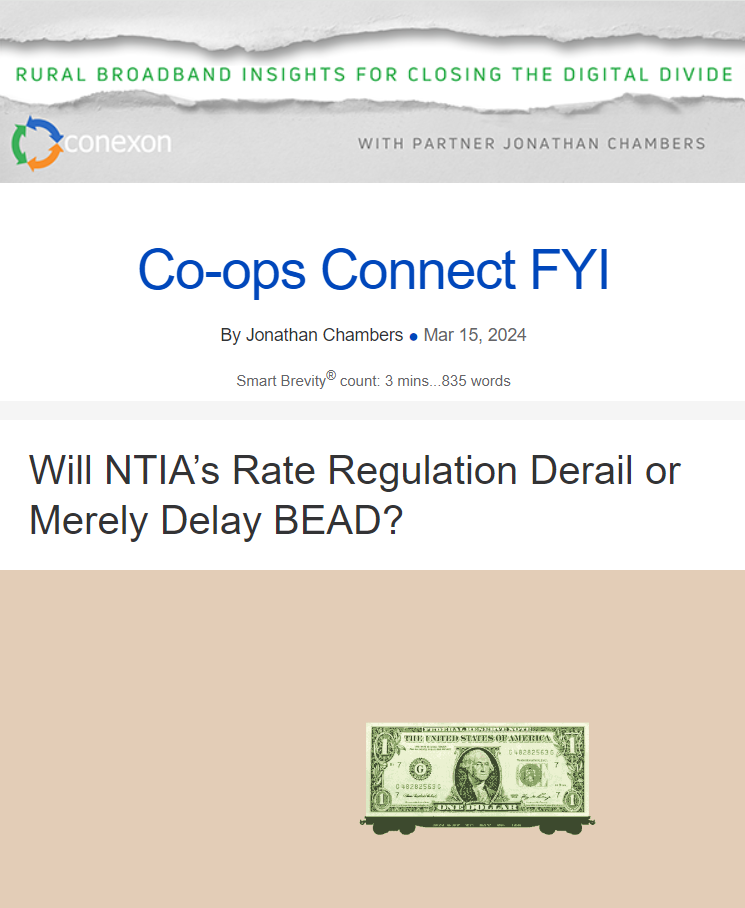Will NTIA’s Rate Regulation Derail or Merely Delay BEAD?
March 15, 2024
The Infrastructure Investment and Jobs Act that created BEAD was signed into law 2 years and 4 months ago.
- Of the $42.45 billion appropriated by Congress for rural broadband, not a penny has yet been spent on broadband infrastructure.
- As many predicted, the FCC and NTIA have moved glacially on maps, models, and implementing new rules.
In 2022, I wrote:
“At the current pace, BEAD funds won’t create new broadband service until 2025 at the earliest…If Congress had been informed that NTIA’s activities would delay funding rural broadband construction until 2025, I don’t think Congress would have given NTIA the job. Instead, like CARES, Congress would have made funding directly available to states and counties.”
Congress gave NTIA two straightforward jobs:
1. A little arithmetic: Divide $42.45B by the number of unserved locations in the country, according to a formula.
2. A little administration: Review states’ broadband plans.
How it’s going:
By the time NTIA had completed its arithmetic, most states already had experience administering large-scale rural broadband programs, courtesy of the CARES Act and two phases of the American Rescue Plan Act.
- These programs followed rules set by the Treasury Department.
- One might have hoped NTIA, relying on the well-trodden paths, would execute its tasks quickly.
While Congress decided that $42.45 billion should be spent by state governments, not federal agencies, it is difficult for any bureaucracy to let go.
I expected NTIA would delay funding over various policy differences – Davis-Bacon, environmental assessments, new Buy America provisions.
I did not anticipate a fight between NTIA and states over rate regulation.
I didn’t anticipate a fight because the Act that created BEAD plainly states: “Nothing in this title may be construed to authorize the Assistant Secretary or the National Telecommunications and Information Administration to regulate the rates charged for broadband service.” (emphasis added)
Congress had required that states adopt a low-cost option for broadband in BEAD-funded areas. Congress also determined that NTIA should not use BEAD to set rates.
- Setting internet access rates has been a prohibited third rail of public policy since the dial-up internet days.
To read those provisions consistently, a state could have made a determination about affordability, used the FCC’s benchmarks and cost models, required participation in low-income programs or adopted any number of policies. Anything except set rates.
NTIA required states to set a rate for the low-cost option.
The Case in Virginia
Recently, NTIA rejected Virginia’s application for BEAD funds because “the low-cost option must be established in the Initial proposal as an exact price or formula.”
When asked by a Congressional Committee to clarify its position on rate regulation, the NTIA Administrator responded: “It depends on what you mean by rate regulation.”
Virginia, under both Democratic and Republican governors, has deployed over $700 million in state funds on rural broadband networks.
- Like most states, its prior broadband plans required new legislation.
- In short, Virginia has ample experience in administering a rural broadband plan.
Why it matters:
Virginia was ready to move quickly on the BEAD program.
- It was the first state in the country to submit its BEAD application.
- But now, Virginia must wait to receive its $1.5 billion allocation for BEAD. It may need to adopt new legislation in order to move forward.
- The delay may be months — and a standoff could last well beyond the November election.
Politics At Play
This has now become a political issue, and politics often hardens positions.
Last week, over 20 conservative free-market organizations wrote the House Energy and Commerce Committee urging it “to hold NTIA accountable for its lawlessness.” (emphasis in the original; read in full here)
The House Energy and Commerce Committee had already written NTIA, stating that “NTIA is administering this program in violation of the law.” (read in full here)
For its part, NTIA has taken the view that establishing an exact price for broadband is necessary to make service affordable.
- There is often a trade-off between rate regulation and quality.
- In this case, NTIA’s proposed low-cost option will hamper the deployment of fiber networks in BEAD eligible areas. (see Feb 2 Co-ops Connect FYI)
The Final Word
I don’t expect NTIA to listen to substantive arguments.
- The Biden Administration has been touting infrastructure since 2021.
- NTIA will claim that it is sticking up for low- and middle-income households.
It is possible that both sides will drop the politics and finally deliver the promised BEAD funding.
It is more likely that this will become a red state/blue state divide.
Because I am in the solutions business for the delivery of broadband to more rural Americans, I would offer this additional prospect; that perhaps Congress will grow tired of NTIA’s delays and put a rider on an appropriations bill that says something like:
Within 30 days of any state’s application for BEAD funds, NTIA shall grant requests for the allocated amounts to any state that presents a broadband plan certified by the governor. NTIA shall have no authority to deny funds for state-certified broadband plans
To be clear, Conexon isn’t waiting for BEAD. We’re building.
